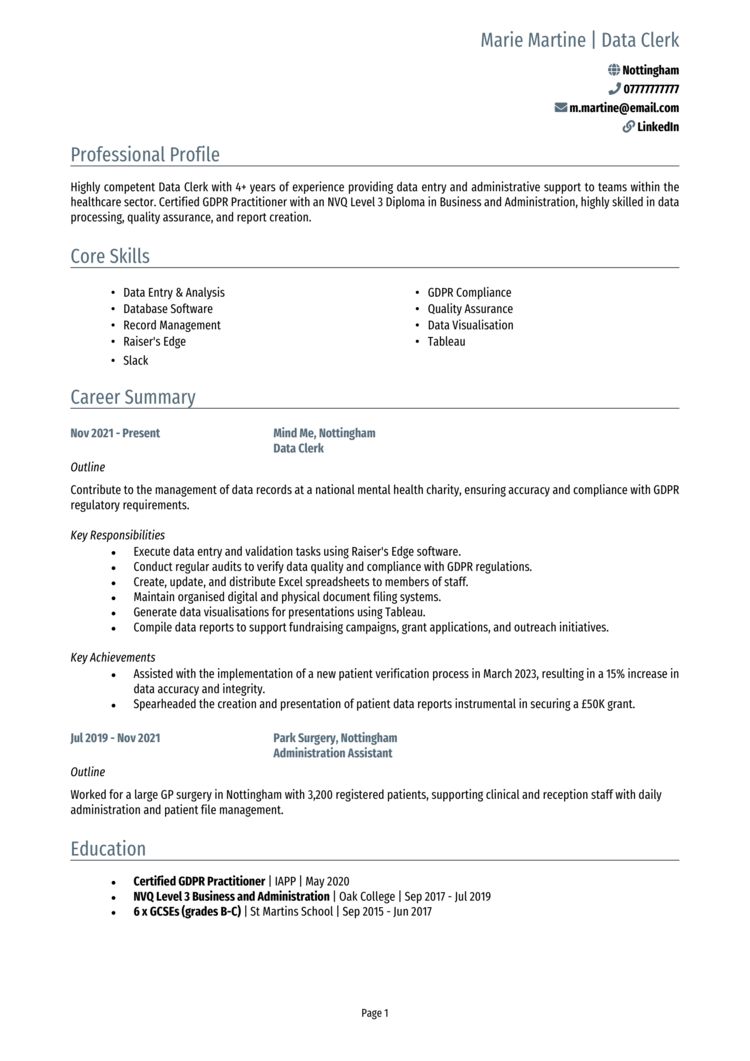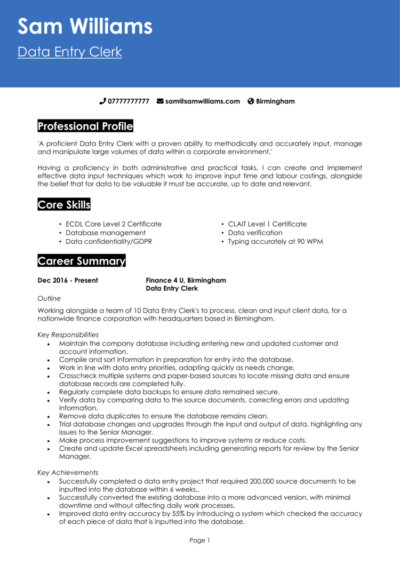As a data entry clerk, your attention to detail and speeding typing are essential skills to any organisation.
But in such a competitive field, you’ll need a CV that manages to put you above the rest.
This guide, complete with 2 Data Entry Clerk CV examples, will help you create an application that’s as precise as your typing.
Data Entry Clerk CV example

Data Clerk CV example

How to write your Data Entry Clerk CV
Learn how to create your own interview-winning Data Entry Clerk CV with this simple step-by-step guide.
Learn everything needed to write a Data Entry Clerk CV that highlights your accuracy, time management, and proficiency with data management tools. You’ll have a CV that opens doors to your next role.
The correct structure for a Data Entry Clerk CV


Your CV should be as structured and easy to follow as the databases you manage. Recruiters want to quickly see your technical skills, data-handling experience, and ability to maintain accuracy under pressure: don’t make them struggle to find it.
Here’s how to structure your Data Entry Clerk CV:
- Name and contact details – Place these at the top for easy reference. Including a photo is optional.
- CV profile – Immediately draw in the recruiter with a brief summary of your skills and experience
- Core skills – At a glance, state your abilities, such as typing speed and software proficiency.
- Work experience – Go through your roles in reverse chronological order, focusing on tasks and measurable achievements.
- Education – Here is where you can outline the academic qualifications like degrees and any certifications in IT or data management.
- Additional info – Mention any other skills or recognitions that convey your knowledge and genuine interest. This section is optional, but often enhances a CV.
Data Entry Clerk CV format


Your CV format should mirror the clarity and efficiency you bring to your data entry tasks. Even the fastest typist can miss out if their CV is poorly presented.
Follow these formatting tips for a Data Entry Clerk CV:
- Bullet points – Use these to make tasks and achievements easily skimmable.
- Divide sections – Make use of distinct headings and logical spacing to guide recruiters through your CV.
- Use a clean font and layout – Choose a professional, readable font that keeps the focus on your content.
- Keep it under 2 pages – Focus on your most relevant skills and accomplishments without overwhelming the reader.
The best way to write a Data Entry Clerk CV profile


Your CV profile is your chance to highlight your data entry expertise and make a strong first impression. This section should emphasise your speed, accuracy, and ability to handle large volumes of data efficiently.
Data Entry Clerk CV profile examples
Profile 1
Detail-oriented Data Entry Clerk with three years of experience in the retail industry, specialising in maintaining accurate inventory records and processing large datasets efficiently. Proficient in Microsoft Excel, Google Sheets, and data management systems to ensure precision and reliability.
Profile 2
Organised Data Entry Clerk with two years of experience in the healthcare sector, focusing on patient record management and database updates. Skilled in data validation, entry, and ensuring compliance with GDPR and other confidentiality regulations.
Profile 3
Efficient Data Entry Clerk with over five years of experience in corporate environments, adept at handling high-volume data entry tasks, reconciling discrepancies, and producing detailed reports. Proficient in SAP, QuickBooks, and other enterprise resource planning tools.
What to include in your Data Entry Clerk CV profile
Tailor your profile to the role by focusing on the tools and techniques you’re experienced with and the impact you’ve had in previous positions.
What to include in your Data Entry Clerk CV profile:
- Where you’ve worked – Mention the types of organisations you’ve supported, and how much experience you’ve got there.
- Your top qualifications – Highlight certifications like IT diplomas or typing speed accreditations.
- Key data-handling skills – Include proficiency in Excel, data verification, and document management.
- Accuracy and speed – Reference your ability to meet deadlines while maintaining high accuracy rates.
- Tools and systems you’ve used – Mention experience with databases, CRMs, or specialised software.
Core skills section


The core skills section is like a quick-reference guide for recruiters. This is your opportunity to showcase the technical and organisational abilities that make you a standout Data Entry Clerk at a quick glance
Top skills for your Data Entry Clerk CV
- Typing Speed and Accuracy – Consistently achieving error-free typing at 60+ words per minute.
- Data Verification – Ensuring information is correct and consistent across systems.
- Spreadsheet Management – Proficient in creating and maintaining Excel sheets with advanced formulas.
- Database Entry – Experience inputting and updating information in systems like Salesforce and SAP.
- File Organisation – Maintaining digital and physical records for easy retrieval.
- Time Management – Meeting deadlines without compromising accuracy.
- Document Formatting – Preparing reports, invoices, and correspondence to professional standards.
- Data Cleanup – Identifying and correcting duplicate or inconsistent entries.
- Email Correspondence – Managing data received through email, ensuring timely updates.
- Confidentiality – Handling sensitive data securely and in line with GDPR or other regulations.
Work experience


Your work experience section is where you demonstrate your ability to handle data entry tasks accurately and efficiently. Focus on roles that showcase your technical skills, attention to detail, and organisational abilities.
List your roles in reverse chronological order. If you’re newer to the field, include internships, volunteering, or administrative roles that demonstrate transferable skills.
Writing job descriptions for past roles

- Outline – Briefly describe the organisation, your role, and the data systems you worked with.
- Responsibilities – Highlight tasks like entering customer details, verifying invoices, or managing data backups. Use action verbs like “processed,” “verified,” or “updated.”
- Achievements – Include measurable outcomes, such as increasing data accuracy or reducing processing time. Numbers always add impact (e.g., “Maintained 99.8% accuracy rate on data entry for 5,000+ records monthly”).
Job examples for a Data Entry Clerk
Data Entry Clerk | H&M
Outline
Maintained accurate inventory records for a retail chain, focusing on efficient data entry and error resolution. Supported the operations team by ensuring up-to-date and accessible information.
Responsibilities
- Entered product details into the inventory management system with speed and accuracy.
- Verified data entries for errors and inconsistencies, correcting discrepancies promptly.
- Generated daily, weekly, and monthly inventory reports for management review.
- Communicated with suppliers and internal teams to update stock information.
- Maintained data confidentiality in compliance with company policies.
Achievements
- Improved data entry accuracy by 20% through the implementation of a verification checklist.
- Reduced inventory discrepancies by 15% by identifying and resolving data inconsistencies.
- Recognised for completing high-priority data updates ahead of deadlines.
Data Entry Support | ABC Health Group
Outline
Provided data entry support for a healthcare facility, ensuring accurate and confidential handling of patient records. Assisted the administrative team with database updates and report preparation.
Responsibilities
- Entered patient information into the database, ensuring compliance with GDPR and HIPAA regulations.
- Performed regular data audits to ensure records were up-to-date and free from errors.
- Generated reports for healthcare providers to support patient care and operational planning.
- Worked closely with the IT department to resolve database issues and improve workflows.
- Maintained secure storage and backup of sensitive data.
Achievements
- Reduced data entry errors by 25% through consistent use of validation tools.
- Improved report preparation time by 15% with streamlined data retrieval processes.
- Received commendation for maintaining high levels of accuracy under tight deadlines.
Data Entry Clerk | Pearson Finances
Outline
Managed high-volume data entry tasks for a corporate finance team, ensuring precise documentation and timely updates to company records. Supported finance operations by reconciling data across multiple platforms.
Responsibilities
- Entered financial transactions into the company’s accounting system with precision.
- Cross-referenced records to identify and rectify inconsistencies in financial data.
- Prepared detailed summaries and reports for finance and audit teams.
- Maintained documentation for compliance with internal and external regulatory standards.
- Collaborated with team members to implement process improvements for data handling.
Achievements
- Reduced reconciliation discrepancies by 30% through meticulous cross-checking.
- Streamlined data entry workflows, cutting processing time by 20%.
- Recognised by management for achieving 100% data accuracy over six months.
Education section


The education section highlights the qualifications and training that support your data entry expertise. Include IT certifications or courses that demonstrate your ability to manage data efficiently.
List qualifications in reverse chronological order. For newer candidates, emphasise coursework or projects relevant to data entry or IT.
What are the best qualifications for a Data Entry Clerk CV?
- Level 2 Diploma in IT User Skills – Demonstrates proficiency in essential office and database software.
- Typing Speed Certification – Validates typing accuracy and speed for high-volume data entry roles.
- Microsoft Office Specialist Certification – Highlights expertise in Excel, Word, and other Office applications.
- GDPR Awareness Certificate – Ensures understanding of data protection regulations.
- OCR Level 2 Certificate in Business Administration – Provides additional skills in administrative support and data organisation.





